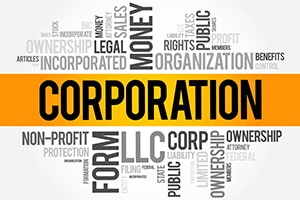
Posted Sunday, December 29, 2024
The big knock on C Corps is that they might be tax inefficient. Wyoming was the first state allowing LLCs in 1970, but most states did not follow suit until the 1990’s. Therefore, if you wanted to avoid double taxation you had to first create a C corporation and then elect S corporation taxation.
Thanks to current tax law changes, corporations now enjoy a 21% income tax rate. But… not all that glitters is gold. Dividends are then taxable to you up to 23.8% (which is 15% to 20% capital gains plus 3.8% of Medicare surtax potentially). Therefore, your effective tax rate for using a C Corp as your entity choice ranges from 36% to 44.8% where the top individual rate of an S Corp shareholder is 37%. This is the double taxation part.
We don’t run into too many business owners who want to make money but never spend it. Sure, you can enjoy a lasting 21% corporate tax rate, but to spend it you need to be taxed again at your dividend rate. Read more in our recent blog post-
If you think you are clever and drive corporate profits down to zero with high owner salaries, this too unnecessarily pays more in overall taxes ultimately (payroll taxes being the main culprit). You will discover in a later chapter that the IRS requires reasonable salaries to be paid to materially participating shareholders in an S corporation (not too low); however, the same is true in a C corporation where an unreasonably high salary is a target for the IRS. Seems odd, but true.
In other words, C corporation plus high salary, Bad. S Corporation plus low salary, Bad. Like Goldilocks, it needs to be just right to the IRS.
Not all is bad with C Corporations.
C corporations generally enjoy better financial liability protection and have much easier transfer of ownership. Taxes are paid at the corporate level to the IRS and states (either through an income tax or a business tax) on Form 1120. Notice the subtle difference; 1120 and 1120S.
Because of the relatively low tax rate as compared to the highest individual tax rate, C Corps can leverage debt reduction at a cheaper rate. How? You buy a piece of equipment with a loan. A portion of the loan payment is principal and is basically paid with after-tax dollars since the interest portion is deducted. Said in another way, you make $1,000 in profits and use $1,000 of it as accelerated debt reduction. You will still pay tax on the $1,000. Yuck.
So, the question becomes, if you must pay taxes on the $1,000, would you rather do it at 21% than 37%? We’ll give you a minute to decide with an optional chin rub. Again, this is predicated on smart budgeting and using excess cash to pare down debt versus that European cruise you’ve been eyeing.
There might be an issue with accumulated earnings tax (AET), but don’t get too hung up on that since depreciation will reduce earnings (tax loss or tax neutrality, but cash “gain”). Then later on down the line you elect S Corp tax status on this C Corp and you have the best of both worlds… reduced income tax for some time, and then avoided double taxation as you start pulling out excess cash.
C corporations are also required for any type of self-directed IRA or 401k, and in some cases where a life insurance policy is being paid for by the corporation (and where the beneficiary is the corporation). For example, if you wanted to open a business with a rolled over IRA it would typically need to be a C corporation. However, some IRA trust providers are creating LLCs and funding them with a self-directed IRA. The jury is out on the legality of this, and there are enough attorneys and legal professionals on either side to warrant concern.
If you wanted a life insurance policy on your best sales producer, these are sometimes restricted to C corporations only (essentially, it cannot be a pass-through entity such as a multi-member LLC or partnership, or any entity taxed as an S corporation).
C corporations might also be necessary for exotic stock options, vesting schedules, different classes of voting stock (one share equals ten votes, Class A or one share equals one vote, Class B) and initial public offerings. If you have these needs, seek an attorney. A smart one.
Don’t forget the golden rule where the person who has the gold makes the rules. Said differently, if an investor or venture capitalist wants to put their money with you, and they will only do so under a C corporation regime, you are stuck between a rock and a hard place.
Wanna Talk About Your Small Business?
Please use the form below to tell us a little about yourself, and what you have going on with your small business or 1099 contractor gig. WCG CPAs & Advisors are small business CPAs, tax professionals and consultants, and we look forward to talking to you!

